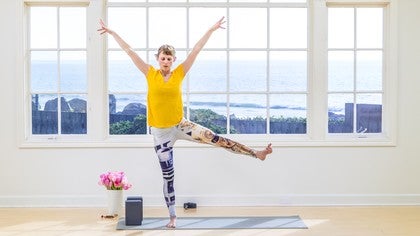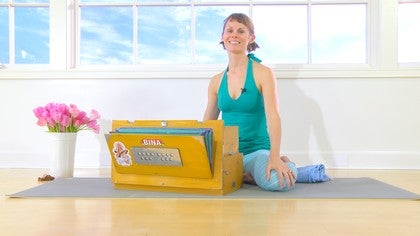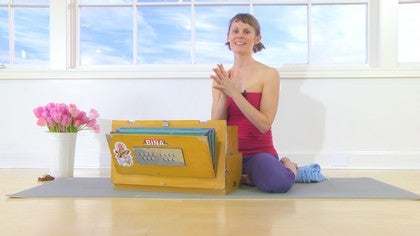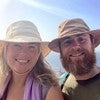Description
About This Video
Transcript
Read Full Transcript
Hi, I'm glad you're here to practice. In this practice we'll be creating some asymmetry in the body, particularly in the area from the hips to the collarbones, in order to work with this idea of creating balance, supporting ourselves in a place of imbalance. Thanks for being here. We'll begin in a loose, comfortable seated position, something like Sukhasana. Feel free to prop up whatever parts of the body would like to be propped.
Settle into your seat. And once you're settled, relax into the length of your spine that's already happening and you might close your eyes. And as we settle into the seat and relax into the length of the body, your awareness, your concentration might already be invited to your breath. And without forcing anything, we'll bring our awareness to what's happening already around the left nostril. Notice what it feels like to breathe in and out through the left nostril.
And you might find that as you're focusing your attention on that left nostril, your awareness travels to the left side of the body in its completeness. Just notice what you feel. And so while you're focusing on the left nostril and the left side of the body, you might be feeling something like aliveness or vibrancy. Notice what you feel in the right side of the body as your focus has been on the left nostril and the left side. And we'll invite the awareness to shift, to migrate to the right nostril, beginning by noticing the sensation of breath as it's already passing through that place.
There's nothing to force. There's nothing to do other than to notice what's already happening. And as with the left side, your awareness might begin to spread and stretch across the entire right hemisphere of the body. Recognizing what you feel. And with your awareness still in the right side, notice the general feeling in the left side of the body, the side where all of your attention is not.
Soften the effort of being so intimate with your breath around the nostrils and being so focused with sensation. Really begin to open the eyes, allowing sight to return just as it does. And from here, we'll start to walk the right hand or slide the right hand out to the right. And there's no fancy way of doing this. Just do what feels good.
Maybe the left hip floats up. Maybe it anchors itself. And you might bring the left hand to the left hip or the ribs. In time, you might reach that hand toward the sky. And at the pace of your own breath, let the exhalations round the back and let the inhalations arch the back.
And there's no right or way to do it than how you already are. These movements can be really close to the spine, almost invisible. Or they could be really swoopy and cursive and obvious. Just notice what you're feeling in your body right now. And in time with a breath in, we'll stay in that tipped over position, but we'll come to a neutral spine and reach the left hand toward the sky, maybe let a little bend happen in the elbow as you experiment with the rotation of the shoulder.
And you allow for this sensibility of receptivity in the left side of the body. And so for lots of us, it will feel very obviously that we're lengthening the left side here. Can you breathe a little bit of buoyancy into the right side, the hidden side, the dark side of the moon? It's still there. And with a breath in, start to reach that left hand back up toward the sky, letting it pull you up.
And as you exhale, release the arm down, and notice what you feel. Left side of the body, right side of the body, and right down the center. So we'll shift back and change the cross of the legs, and we'll walk the left hands out to the left. Again, just let it feel good. Maybe go too far until you tip over and then come back a little bit.
Bring the right hand to the hip or the ribs just to sort of feel what's happening there, reaching the right hand toward the sky. And at the pace of your own breath, let the exhalations round the spine, and the inhalations arch the back. And it's useful, it's helpful, it's totally awesome if you let each of your parts have its own experience, like from the tips of your fingers to your eyebrows. And to notice what you feel in those places. No one else needs to get it, what you're doing at all, ever.
And in time, we'll let the breath in, bring the spine to neutral, extending the right hand toward the sky, and it's almost as if we were breathing with the right side of the body. So we're sort of like opening ourselves to receive what's being offered on the right side. Find a position for the neck and head where you feel ease. And then breathe some life, some vibrant breath into the left side. And as you breathe in, reach the right hand toward the sky, let it pull you up, and as you exhale, release the right hand, and notice what you feel.
And in time, we'll make our way to all fours, hands and knees, and it will be helpful and useful if you have two blocks to bring them to the top of the mat. So they're within easy reach. And really take your time to find your way into table pose, like move the body around, shift things around until you feel stable, secure, strong. Breathing in to the fullness of the back of the body, the breath of the shoulders. And as you breathe out, tuck the toes under, move the hips toward the heels, press the palms of the hands into the floor as you lift the knees away from the earth and unfurl into downward facing dog, Adho Mukashvanasana.
And really get to know this shape, downward facing dog, like feel around for the edges of the container. Start to notice what's happening from the points of the hips all the way to the collar bones in this shape. And with a breath in, we'll bend the knees a bit, step the right foot forward to a lunge. And this is a good place for us to elevate the hands onto blocks. So we have lots of room for length here, and we're not struggling to get somewhere at the expense of the spine or the belly.
And we can relax and appreciate the length, this elegant length of the body that's already happening. Can you appreciate the distance from the center of the left heel to the belly button? And from the belly button to the heart, and from the heart to the forehead. And from here, we'll create a little bit of structure, stability. Bend the left knee a little bit, engage the left glutes to support you.
Bring the right hand to the top of the right thigh, and to start, we'll let that left arm just dangle, easy in the shoulder. With a breath in, we'll start to sweep the left arm forward as if you were trying to reach for the wall in front of you. So we have all this length happening in the left side of the body. Temper that with a little structure. Engage the glutes, engage the glute.
And then breathe into this right side of the body, so you create some symmetry from hip to armpit. With a breath in, we'll release the hands back down to the floor, and we'll exhale to down dog. With a breath in, we'll bend the knees and step the left foot forward, finding that lunge. There is so much space already happening in your body. Let yourself treasure that.
Appreciate the distance. You might even be tracing the path within the body to the heart, to the space between the brows, and then creating a little structure here by bending the right knee a little bit, engaging at the glutes, drawing the belly toward the spine, opening at the heart, and then bringing the left hand to the top of the left thigh. Breathing in, reaching the right arm forward, finding length, softening at the shoulder, releasing buoyancy into both lungs. There's symmetry within asymmetry. As you breathe in, release the hands to the floor, and we'll breathe out to down dog.
And as you breathe in, lower the knees to the earth, luxuriously, table. And we'll start to move toward anahatasana, walking the hands forward, letting the heart descend. Forehead comes to rest on the floor. If this is making your shoulders grouchy, move the elbows closer to the shoulders. And from here, we'll start to slide the right hand back, just so that it's next to the right side of the face.
Press the right hand into the floor as you start to walk the left fingers to the top of the mat before setting the elbow back down. So length is happening in the left side of the body. Notice what's happening in the right side of the body. You might be curling in there or softening. That's normal.
Breathe into the buoyancy of that lung, and then soften at the shoulders. And with a breath in, let's slide the right hand back forward, soften the heart. Notice the right side of the body. Notice the left side of the body. And with a breath in, we'll slide the left hand back.
So it's just next to your ear, next to your face. Press those fingers lightly into the floor as you walk the left fingers to the top of the mat and soften at the shoulders. Notice the length, the distance from your right hip over the armpit, all the way out through the fingers, and then breathe buoyancy, life vibrancy into the left side of the body. Press the palm of the left hand into the floor as you breathe and slide the right hand to the right side of the face and press up to table. Notice, notice.
And with an exhalation, tuck the toes, move the hips toward the heels and towards downward facing dog. And with a breath in, we'll step the right foot forward between the hands, stabilize here as you lower the left heel to the floor and rise all the way up to stand. Just check in with the arrangement of the feet. Notice where they are. Check in with what is already naturally happening with your hips in this standing position.
We'll inhale the arms out to T. And as you exhale, start to slide the hips toward the back of the mat, toward the left as the upper body reaches toward the top of the mat. And let's do that one more time, breathing in, rising up. And as you breathe out, slide the hips toward the left, upper body toward the right. Bring your left hand to the left hip and release the right hand, maybe to the shin, maybe to the thigh, to a block or to the ankle. There's no race to the bottom here.
There's no prize for touching the floor. The idea is for us to work with this arrangement of bones and organs and cells, and notice what's happening. Hand on the hip. See if you can breathe a little bit of life, a little vibrancy into the lower part of the body, from the hip to the armpit. Find ease in the neck.
And from here, let's go a little bit crazy with the right hand. You might reach back toward the back of the mat. I know. Is this trikonasana or not? Reach back toward the back of the mat, maybe reach toward the sky.
Notice how that shifts things. And then reach overhead. Ah. Breathe in, cartwheel the hands toward the earth, and we'll breathe out and step back to down dog. Notice the right side of the body.
Notice the left side of the body here. As you breathe in, bend the knees, step the left foot forward, stabilize as you lower the right heel toward the floor, and come all the way up to stand. Repeat making purposeful contact with earth, hands feeling around for landmarks. Breathe in, extend the arms out to T, and as you breathe out, shift the hips toward the back of the mat as the upper body reaches all the way to the top of the mat. Press the feet into the floor.
Let's do that one more time. Use your legs here. Breathe in, and as you breathe out, slide the hips to the right upper body toward the left, releasing the left hand down, and first bringing the right hand to the right hip. And don't be afraid to try something here. Let's go the opposite way on this side.
So let your right arm dangle, let it swing, and then reach forward, ooh. There's like a little internal rotation happening in the right hip. Reach toward the sky, lengthen the left side of the body, and then reach back behind you. My gaze sort of naturally wants to follow the right hand. We'll breathe in and release the hands down, and as you breathe out, step the right foot forward to meet the left.
You might gather your blocks here as you dangle in a forward fold. Let the crown of the head be heavy. Let the back of the skull be soft. And there's nowhere you need to get to here. The idea is to hang from the hips.
Knees might really bend. How can you relax the jaw? And so either with hands on the shins or the block, as you breathe in, bring the torso up halfway, lengthen from the tailbone all the way to the crown of the head, and as you exhale, fold forward. And we'll do that again. This time, focus on lengthening the front of the body from the pubic bone to the place where the forehead and the hair meet.
I think some people call that the hairline. And exhale, fold. And we'll do that one more time. Breathe in, press the feet into the floor, lengthen the spine, and we'll pause here. Notice what's happening in your legs.
What happens if you actively engage the glutes? Yeah, where else do you feel that in the body? Soften the effort a little bit, bend the knees just a touch, just a touch. Your hands might stay where they are. You might even bring them to the top of the knees as you let the tailbone get a little bit heavy.
The tailbone is just becoming more sensitive to the gravity that's already happening. Invite the belly to move a little bit closer to the spine, the belly button. And invite the heart to bloom from here. Your hands might stay where they are. You might just sort of let them drop and dangle.
As you breathe in, you might sweep them forward and up. And as you breathe out, let them soften at the elbow, soften in the shoulder. And as you exhale, fold forward. Breathe in, press the feet purposefully into the floor, and roll all the way up. You might keep that going, sweeping the arms, hands, and fingers toward the sky.
And exhale, bring everything back to the heart. And so from here, we'll start to shift our weight into the right foot. You know, and just kind of play with it, like notice what it takes to feel the support of the right foot. Let everything settle into the bones. Notice I'm coming to the ball of my left foot.
You can do that too, but you don't have to. And with a breath in, we'll start to lift that left foot away from the floor. Let your left hip, your left booty get a little bit heavier, and it's in the pocket there. And we'll bring the arms out to T. We'll bend at the elbows, soften at the shoulders, and we'll start to cross the left leg up and over top of the right. Maybe the top of that left foot hooks behind the right calf, doesn't have to.
Try not to worry. As you breathe in, start to close the book of the arms, and we'll rest the right elbow in the crook of the left arm. Maybe the backs of the hands touch, maybe the palms of the hands touch. Lift the elbows away from the chest, soften the shoulders. Notice what's happening there.
You're getting this little massage inside the body. Tailbone gets a little more attentive to gravity. Maybe the belly button moves toward the spine a tick, heart blooms, shoulders soften. We'll take a breath in, and just like a big eagle, let it go, exhale, release. Be with what's happening in your body right now.
Notice the right side, notice the left side. We'll start to find the balance, the stability in that left foot. Can you feel all of your toes? In time, we'll lift the right foot away from the floor. Let everything settle into the pocket of that right hip as you breathe in and bring the arms out to T. Bend at the elbows, and we'll start to cross that right leg up and over top of the left as you start to close the book of the arms.
Soft shoulders, soft hands, rest the left elbow in the crook of the right elbow. Maybe backs touch, maybe palms touch, soften the shoulders with the hands from the face, elbows lift from the chest, invite the shoulder blades to move down the back. Can you feel the right side of the body? Can you feel the left side of the body? Breathe in, breathe out, let it go.
Shake it out. We'll start to meander into a squat. Same rules apply here, knees and toes are working together. You might shift your weight into the balls of the feet, let the heels lift a little bit. Soft ankles, super soft.
Start to bend the knees, lower the tush, and let things get a little bit heavy here. Soften the tailbone. It's hard to soften the ankles, but send that instruction. It might feel like nothing happens, but keep sending the message. From here, we'll bring the hands to the floor.
Let the tailbone become even heavier, let the chest become heavy, let the forehead become heavy, let the shoulders become soft. Soft ankles, soft feet. From here, from our squat, our soft ankle squat, we'll bring the hands forward, shift the weight forward so that weight is in the knees, weight is in the balls of the feet. Let your tush back, let the tailbone become heavy, shoulders soft, maybe turn the palms of the hands to face the sky. Soften the jaw.
We don't call it the foot burner for nothing. Yee with your breath. As you breathe out, shift the weight back forward, press the hands into the floor, untuck the toes, maybe let the weight just shift back. We'll make our way into Vajrasana, where we're sitting on the heels. We'll be here for a little bit while we twist, so for lots of us, it makes sense to place a block in its flattest position between the feet and to sit back.
Really settle into the sitting bones, let the tailbone be soft and receptive to the gravity that's happening, notice the places where you might be gripping in your body. Relax into the natural length of the spine. And with a breath out, starting with the face, we'll look to the right, we'll let that shift in gaze, move into the throat, move into the chest, and from shoulder to shoulder, you might place the left hand on the top of the right thigh, you might place the right fingers just on the floor right behind you, no weight is really in them. Maybe looking over the right shoulder, settling into the sitting bones. We're super stable here from the tailbone to the solar plexus, and so the twist is happening in this upper register of the spine.
Now keeping the low part of the body, so from the neck down, twisting in this way, as you breathe out, start to look over the left shoulder. And as you breathe in, come back to center with everything, and notice right side of the body, left side of the body. There might be parts where you are just starting to grip and hold out of habit, and that's normal, but invite them to soften. And with a breath out, we'll start to look to the left with the head, the throat, from shoulder to shoulder, maybe bringing the right hand to the top of the left thigh, and the left hand just to the floor right behind you, just for support and guidance. Soft in the shoulders, maybe looking over the left shoulder.
Notice the distance from left to right shoulder, with the face only, look to the right. And as you breathe in, bring everything back to the center. What do you feel? So we'll come down onto the floor, onto our backs, and you'll need your block and your strap, we finally get to use the strap. Doesn't have to be a strap, you know, it could be a scarf or a bathrobe, belt, whatever you have.
And I must confess that getting the props organized for this next pose is harder than the pose. So start by placing the block between the thighs, so if you at home feel like you're having a hard time lassoing your feet, you're not alone, you'll get to see me do it too. Draw the knees in toward the chest, unroll the strap, and loop the strap around the soles of the feet. With an exhalation, extend the legs toward the sky, and if you notice that you're doing like a thigh master death grip, soften the thighs a little bit. Let the hands move down the strap enough so that your shoulders are easily relaxing into the floor, settling into the floor.
And so the work here is to keep the sacrum settling onto the floor. So you might start to actively engage with the strap and start to draw the tops of the legs toward the torso. Stop there and invite the sacrum to become heavy. Draw the tops of the thighs in, sacrum becomes heavy. You might even roll the shoulders up, back, and down.
And as you breathe out, relax the grasp on the strap, draw the knees to the chest, release the strap, move it out of the way, move the block out of the way, and we get to do something really satisfying here. We get to place the hands on the tops of the knees and start to gently push them away from the torso until gravity pulls them to the floor with a thud. To thud is to be brave. So maybe do it again. Draw the knees in, push.
Feels good to just be loud with your body. Press the feet into the floor, press the small of the back into the floor. And notice what you feel. And we'll make those last movements that the body feels is necessary before we start to move to a shape of rest or integration. And that shape can be lying on the back or the side or the belly with legs up the wall or sitting.
Let the earth hold you. Stay here as long as you like, but when it's time to move, you might begin by noticing the contact that you are making with the earth and settle into that contact even more. And then notice the contact that you, your body is making with the sky, the air and space all around you. And can you be drawn into that contact? Seeing this sense of grounding and this sense of rising at the same time.
From there, bring movement back into your body. In a way that feels natural, inevitable and unselfconscious. And in your own time, in your own way, we'll make our way back to a seat. Maybe the hands come to the heart. Thanks for sharing this practice, peace.
Practical Magic
Comments
LOVE.
You need to be a subscriber to post a comment.
Please Log In or Create an Account to start your free trial.














